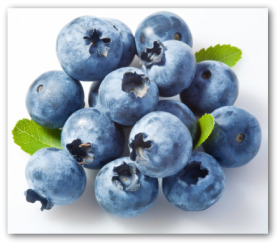Best Tips for How
to Grow Blueberries
We offer the best tips on how to grow blueberries when home vegetable gardening!
Learn how to plant, grow, prune, and harvest blueberry bushes in your backyard.
Design Your Own Vegetable Garden Layout Using our Free "Vegetable Garden Planner" Software!
Pollination is of interest to fruit growers who are searching for information on planting blueberries, raspberries and strawberries.
Edible fruits that produce self-pollinating flowers are considered self-fruitful.
Gardeners can plant a single variety of these plants and produce a bountiful crop.
Blueberries, raspberries, and strawberries are all self-fruitful plants.
However, gardening experts recommend planting at least two varieties of cross-fruitful cultivars to provide crops with better taste, size, and yields.
How to Grow Blueberries
Planting Blueberry Plants
- Plant two-year-old plants in the spring.
- Space high bush blueberries 6 feet apart in all directions.
- Space rabbit-eye plants 7 to 8 feet apart.
- Set plants at the same depth they were growing at the nursery.
- Plant blueberries in full sun to partial shade.
- The bushes prefer well-drained, acid soil rich in organic matter.
- Blueberries will tolerate both sandy and clay soils as long as they are acidic and drain well.
Download Free Garden Planning Worksheets, Garden Diary, Zone Chart, Or Planting Guide
Propagation Methods for Growing Blueberries
How to Grow Blueberries by Mound Layering
Mound layering is primarily used on low, bushy shrubs that produce a lot of shoots close to the base of the plant.
In mound layering, the shoots are not laid in the trench but are instead allowed to grow vertically.
It is best to use shoots of the current season.
As they grow, mound soil around them in two or three stages as they get taller.
Roots form inside the soil mound.
How to Grow Blueberries by Stumping
A variation of mound layering used for larger shrubs, such as large-fruited blueberries, is called stumping.
In stumping, you cut the old shoots off the stem at ground level, then mound a moist mixture of sand and peat moss on top of the stump to a depth of about 4 inches.
You can nail together a simple frame of boards to place around the mound to hold it in place.
Shoots will grow from the old stump and will form roots within the mound.
Keep the sand-peat mixture moist until fall.
When the new shoots have rooted, cut off and transplant the young plants.
How to Grow Blueberries from Cuttings
- Blueberries can also be propagated from cuttings.
- To propagate from stem cuttings, take a 4 inch stem cutting from the bottom of one-year-old shoots in early spring while plants are still dormant.
- The cuttings should have no fruit buds on them.
- Fruit buds are fatter than leaf buds.
- Root the cuttings in moist rooting medium.
- Plant them out when roots have formed.
Pruning Blueberry Bushes Before Planting
When planting bush fruits such as blueberries, remove any fruit buds you find on the bush.
Cut the bushes back by one-fourth and remove any low stems near the base of the plant.
The plants should not be allowed to bear fruit during their first season in the garden.
Varieties of Blueberries
- Highbush blueberries can be grown all along the East Coast and as far west as Michigan, Missouri and Arkansas.
- Rabbit-eye blueberries are selected in the Southeast since they tolerate more heat and need less winter chilling.
Humidity Chamber for Starting Seeds or Root Cuttings
How to Grow Blueberries from Root Cuttings
A simple humidity chamber used for starting seeds or root cuttings, increases the length of time seedlings can go between watering, making them less time-consuming to care for.
Humidity chambers increase the humidity if the air inside your house is very dry.
Basically, you are enclosing flats and pots in clear plastic sheets in a homemade miniature greenhouse.
Place the plastic over a framework of wire hoops to keep it from coming in contact with plant leaves.
Make the hoops square instead of rounded so the top of the plastic lies flat.
Then condensation that collects will drip down onto the plants and soil instead of running down the sides of the plastic into the edges of the flat.
Put the plastic over the flat after you have planted the seeds or root cuttings in the moistened medium.
Tuck the edges of the plastic underneath the flat.
You may not have to water again for 2 or more weeks.
Remove the cover periodically to allow air to circulate around the plantings.
You might also like to read:






